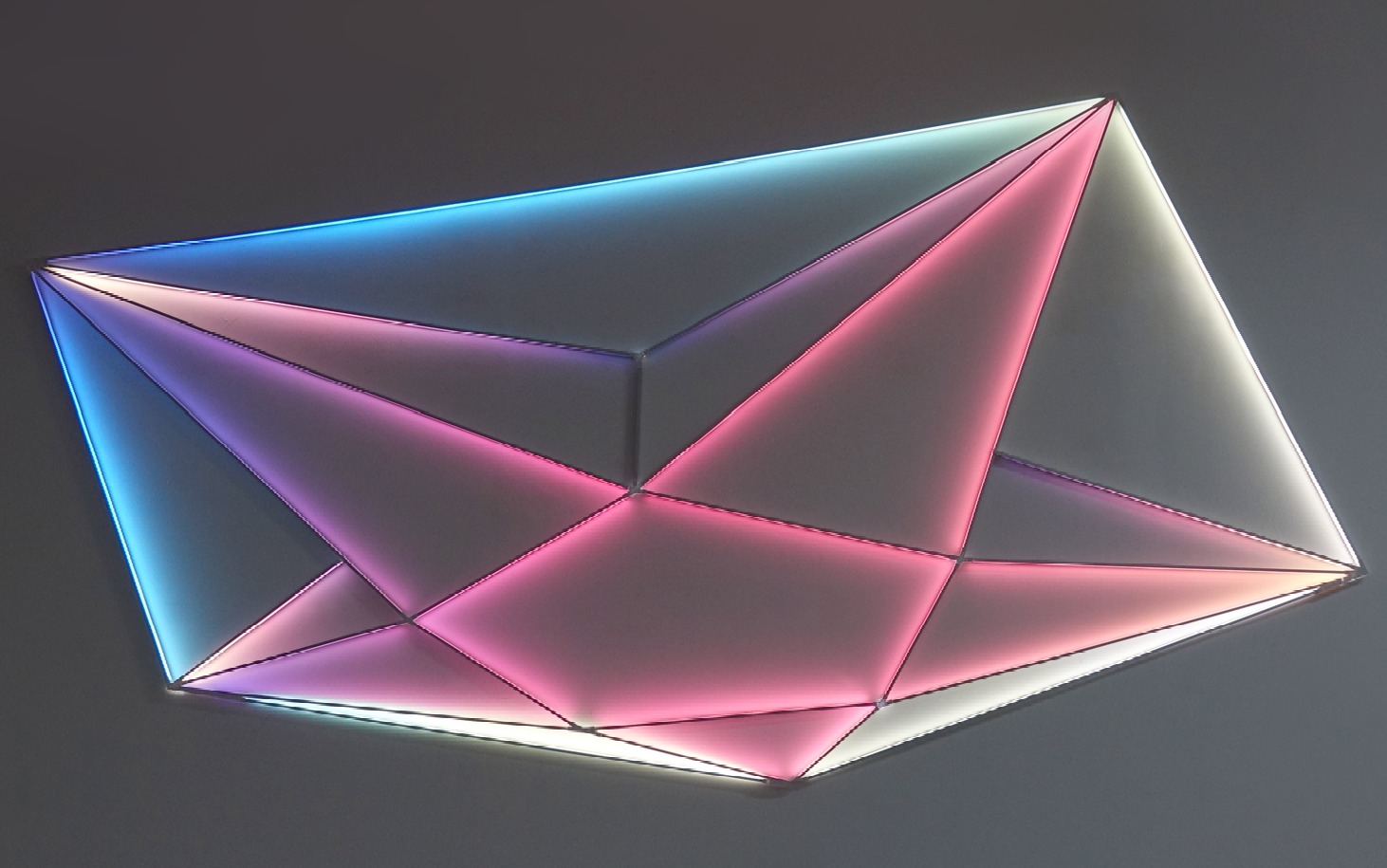
By Force of Nature
James Clar
Silverlens, New York
About
“Chest out. Lift. One motion”—so goes the motto spoken by the Filipino weightlifter and airwoman Hidilyn Francisco Diaz-Naranjo, who, at the 2020 Olympics, became the first Filipino athlete to win an Olympic gold medal since the country’s first appearance in the games nearly a century ago. The video of her glorious win is worth the watch: a sheen of nervous sweat coats Diaz’s brow, and her arms and legs buckle at the joints, but only briefly before she bounds a whopping 127 kilos up from the floor, beyond the frame of her body, and into the air above her. Then the bar is dropped, she steps back exuberant, crying tears of joy. Diaz’s life-long training, and her world-record shattering feat made her an icon to a nation of nearly 115 million, and the many more that compose its diaspora. Diaz plays a crucial role in By Force of Nature, the Filipino-American artist James Clar’s dazzling new exhibition at Silverlens New York. We might read the words of her mantra—as simple as they are precise—not only as literal instructions for what a body might need to defy gravity, but also as a metaphorical premise for the show. What happens to our collective perception of a person who seemingly outsmarts the properties of physics? And what, moreover, must be willed, for the individual to become something not-itself—something like motion itself?
By Force of Nature expands Clar’s decades-long practice of working with light- and screen-based technologies to interrogate the slippages, impositions, and mistranslations that condition life lived in a global diaspora. He incorporates industrially produced materials, animal life, and documentary technique to stage a complex narrative about the weight that identity carries both in Filipino sociality and in the diaspora’s perception of it. The works speak to the uneven translations that occur when the feats of an “individual”—a concept as ubiquitous as it is overdetermined in American culture—becomes imperfectly visible to a populous for whom such a concept is only ever determined in relation to one’s local community, region, or family.
I spoke to Clar via Zoom early one morning this winter; it was night in Manila, and the artist was finishing a late dinner after spending an afternoon at Diaz’s home. We talked about what it was like to grow up in Wisconsin, where life is righteously tied to the ideologies that circumscribe the individual subject—namely, those associated with the American Dream—and the avenues that immigrants and their children must take to assimilate to it. We spoke too about Clar’s own movement—after years of working between New York, Tokyo, and Dubai, he recently decamped to his parents’ homeland, settling in Manila—and about how such a move has inflected the tone and texture of his practice. How do common American ideals, such as that of individual pride or bravado work to limit a diasporic community’s understanding of its own homeland? Inversely, how might these ideals defy marginalization—as might be the case of Diaz—by acting as liberatory tools of personal decolonization? These are just a few of the questions animating the flickering optics that appear in By Force of Nature.
As with Diaz’s mantra, Clar’s exhibition is divided into three parts. They trace the artist’s recent transpacific migration and shifting forms of relating that this geographic relocation entails. In Silverlens’s front gallery space are a series of wall-hanging sculptures that bid adieu to a life lived in the US. THEEN_HEEND_EEND (2023) slows movement down; here, the in-between frames stream the words typically used to end a story, rather than begin it. On an adjacent wall hangs AMERICA (US flag) (2022), a seemingly black rectangle made of iridescent reflective material, its content only rendered visible by the blinding light of a camera’s flash. The second gallery exhibits works that examine the role of artists in Philippine society. Parents (2023), a mixed-media work, includes a video where Clar interviews the parents of prominent Filipino artists. Their speculations about their children’s careers and cultural successes make an angular, communal portrait of contemporary art practice in the Philippines, geopolitical mistranslations become a specifically domestic question. The video plays on a polarized screen along the back wall of a fish tank, inside of which live goldfish—Clar’s metaphor for the artists who are being described—swim freely. The swift, aqueous movements of the fish interrupt the optics, or perhaps they add to it: as with the dialogues in the video, the act of viewing here is a matter of interpretation and interactivity.
In the gallery’s largest space are a series of works that Clar produced in collaboration with Diaz. Mounted along the rear wall is By Force of Circumstance (Hidilyn Diaz Crushed Metal) (2023), made of massive aluminum sheets whose surfaces carry the dents and contortions made by the hulking barbells the weightlifter repeatedly dropped onto them—a visual record of gravity’s impact. Magwheels (1 & 2) (2023) are two, free-standing cylindrical light sculptures that resemble the hefty rims used on semi-trucks, a reference to the found objects an adolescent Diaz trained with before she could afford professional equipment in her hometown of Zamboanga, a region intermittently seized by sectarian conflict. The Center of Gravity (Hip Tensegrity) (2023) uses light to recreate the network of muscle, bone, and mass that, together, compose the pelvic region of a female anatomy. Clar updates the masculinist ideals once proffered by Leonardo Da Vinci’s Vitruvian Man, that massively influential Renaissance-era drawing in which the male body is made analogous to the cosmology of the universe. Highlighting life’s indelible relation to the maternal figure, Clar’s momentous sculptural work recenters how, in even the most basic of geometries, we find nature’s very own ground-breaking form.
– Shiv Kotecha
James Clar is a light and media artist. His interest is in new technological production processes and their application to artistic narrative forms. He studied film at New York University and received his Masters from NYU’s Interactive Telecommunications Program. It was here that he began developing his own light systems to create visual sculptural works that combine light and technology.
His work explores the conceptual and narrative potential of light and technology. These systems are integrated into our daily lives, altering the way we receive information and communicate. They inform our perception of reality, time, and space. Every system for communication enhances certain types of information while limiting and simplifying others. These modulated effects on our perception have become a thematic focus of his works and a way to experiment with narrative forms.
From 2006 to 2012, James’ studio was based in Dubai where he became an active participant in the developing arts and culture scene, working with Traffic gallery and Carbon 12. From 2012 till 2020 he moved back to New York, and in 2021 relocated back to his native Philippines to work with Silverlens gallery within the Asian region.
Clar was an artist in residence at Eyebeam Atelier in New York, Fabrica in Italy, and the FedEx Institute of Technology/Lantana Projects in Memphis. His artwork has been included in exhibitions at Glucksman Museum (Dublin), The New Museum of Contemporary Arts (New York), Pera Museum (Istanbul), Cam Francis Museum (Barcelona), MACBA (Barcelona), and SeMA (Seoul). He has been commissioned to develop large-scale installations for 21c Museum Hotels (Oklahoma), Parasol Unit Foundation for the Arts (UK), and Fraport Headquarters (Frankfurt). James Clar is represented by Silverlens and Jane Lombard Gallery.
Installation Views
Works
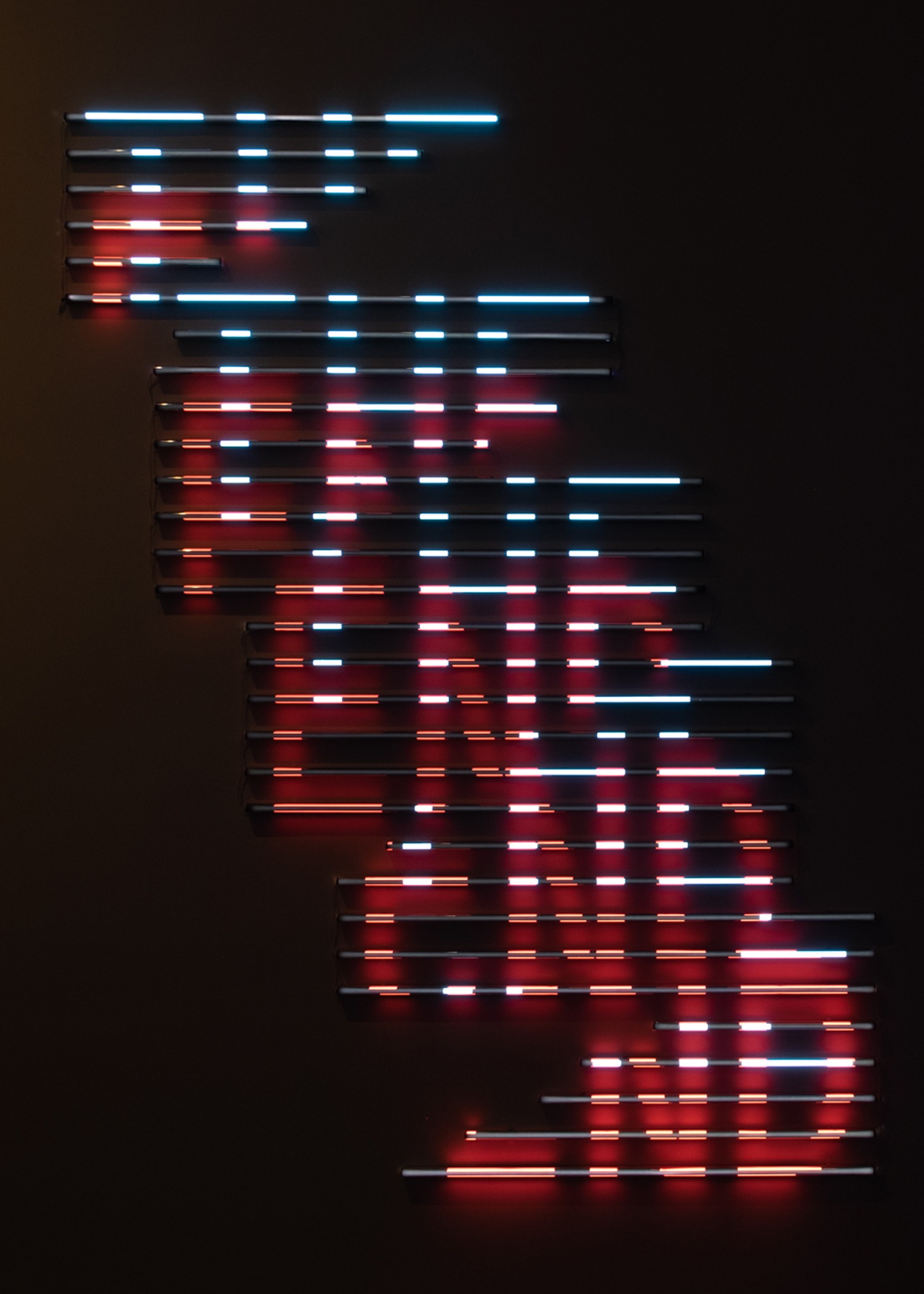
The ending credits of a movie were photographed with a high-speed shutter camera as it played a show’s ending credits to capture the spaces between frames on the screen. The blue direct light spells "THE" while the red bounce light spells "END" to create spatial dimension through light. The final moments of a story are physically expanded when they are slowed down.
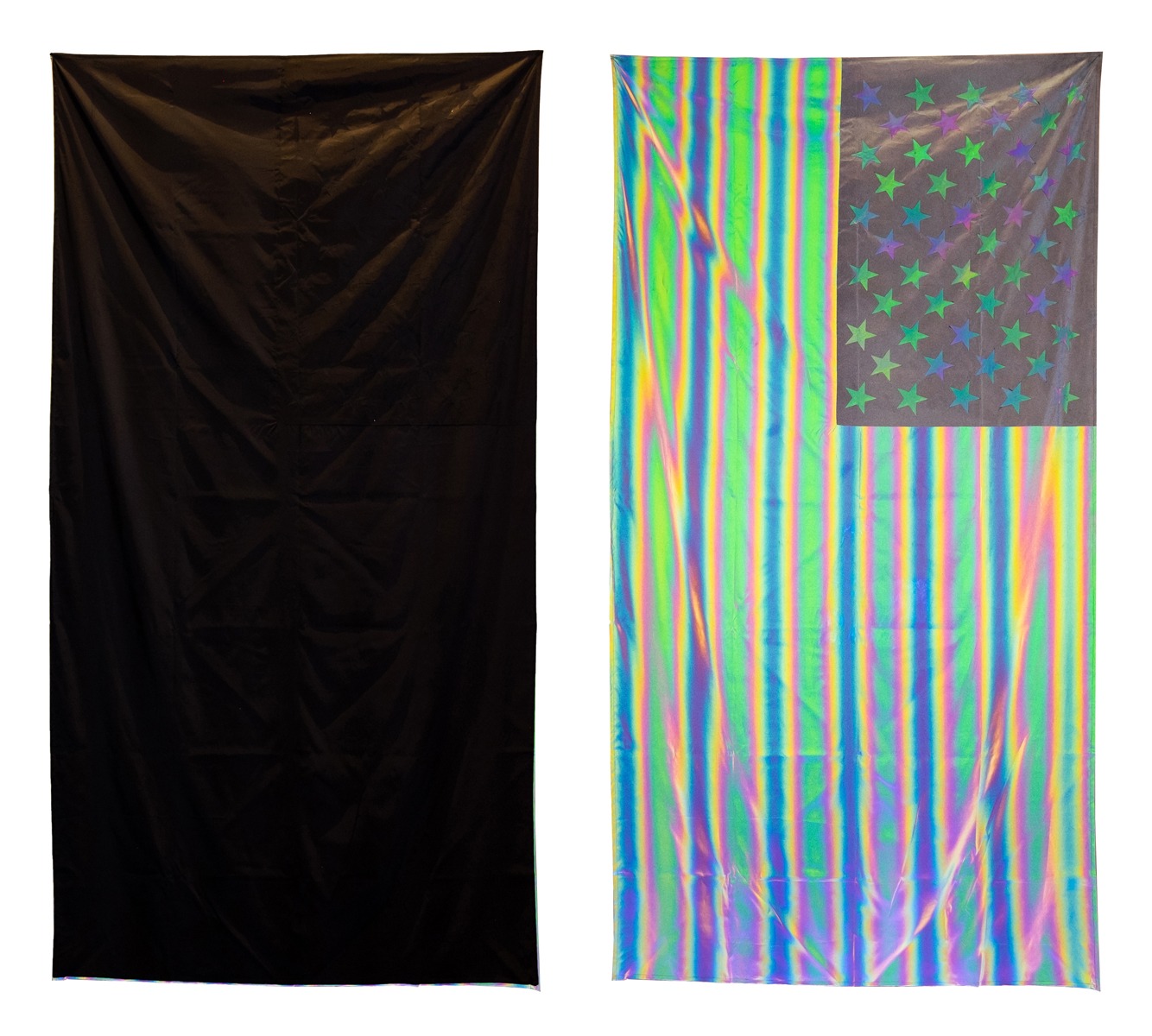
The piece is made from safety reflective fabric that under normal lighting conditions appears to be a simple black rectangle. The act of taking a flash photo however reveals an American flag in glowing hyper-colors. It comes alive “almost like a peacock”, says the artist, a metaphor for his native country’s social and militaristic bravado.
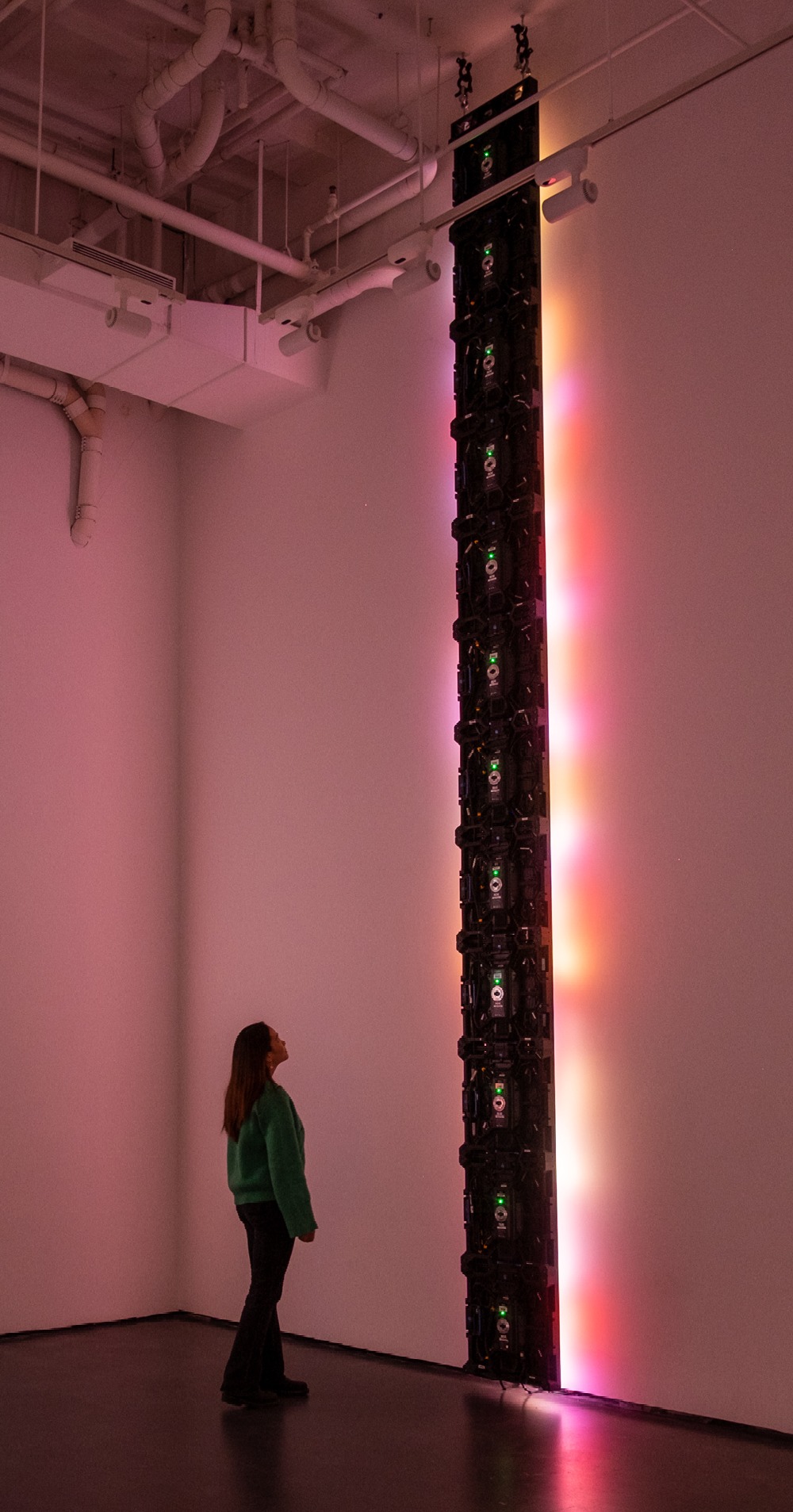
A brainwave reader was connected to weightlifter and airwoman Hidilyn Diaz who, at the 2020 Olympics, became the first Filipino athlete to win an Olympic gold medal. Her brain activity was monitored while she exercised (focus), slept (rest), and watched the playback of her own gold-winning performance (remembrance). The data plays on a tower of LEDs that face the gallery wall. The viewer can see only light seeping out the sides. The light from the streaming data interacts with the physical gallery space giving it form and structure in the same way the body gives form to the mind.
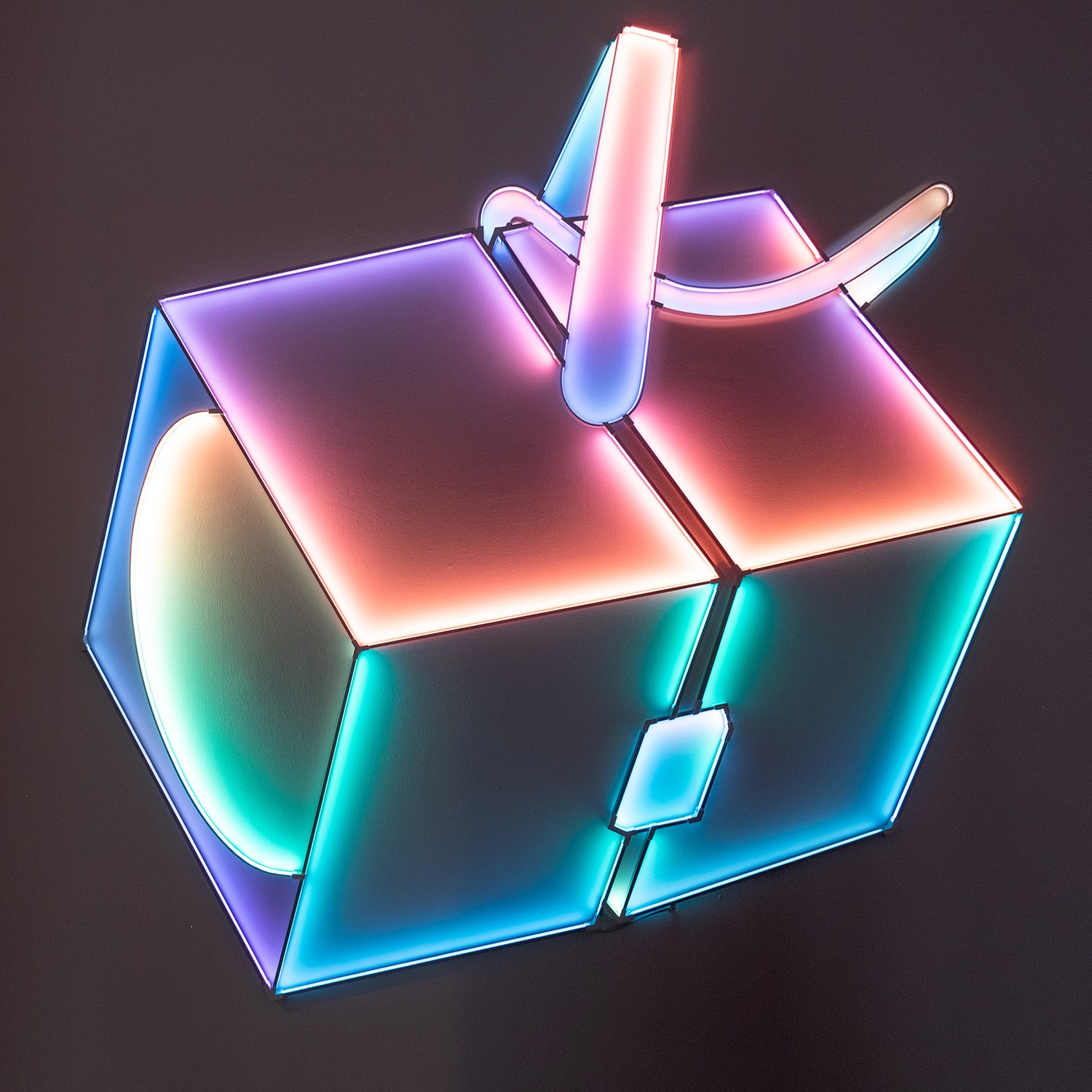
The light fixtures at the Cultural Center of the Philippines were recreated in a 3D modeling software to become the basis of this piece, which turns the fixture into light itself. The original museum lights are utilitarian vehicles for viewing cultural artifacts at the leading arts institution founded by Imelda Marcos. “They act almost like a film projection, with light cast upon an object that creates a story”, says Clar.
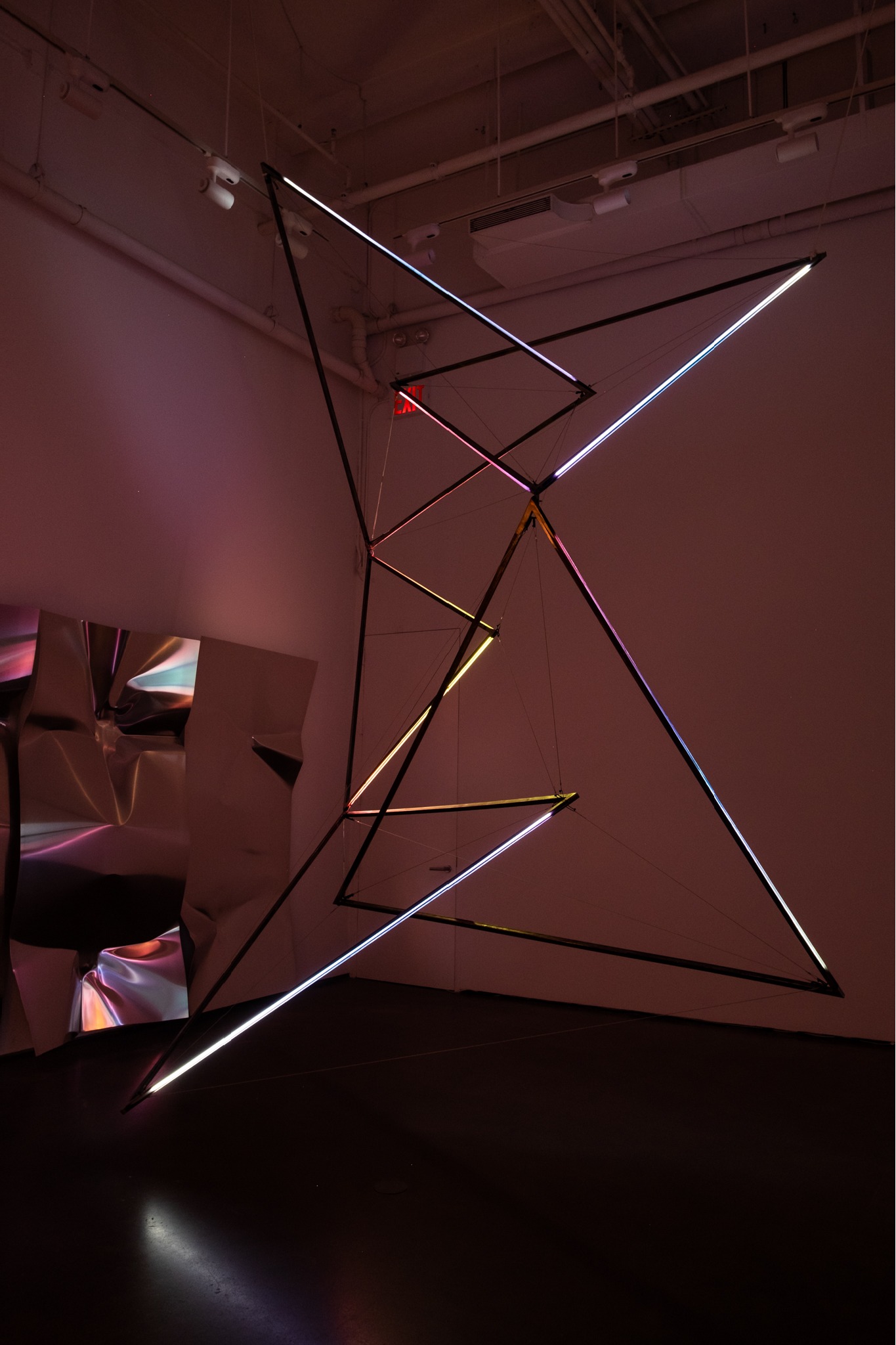
The Center of Gravity (Hip Tensegrity) uses light to recreate on a massive scale the network of muscle, bone, and mass that, together, compose the pelvic region of a female anatomy. It might be read as a monument to the matriarchy and its unifying role in Filipino society. “Highlighting life’s indelible relation to the maternal figure, Clar’s momentous sculptural work recenters how, in even the most basic of geometries, we find nature’s very own ground-breaking form,” says essayist Shiv Kotecha.
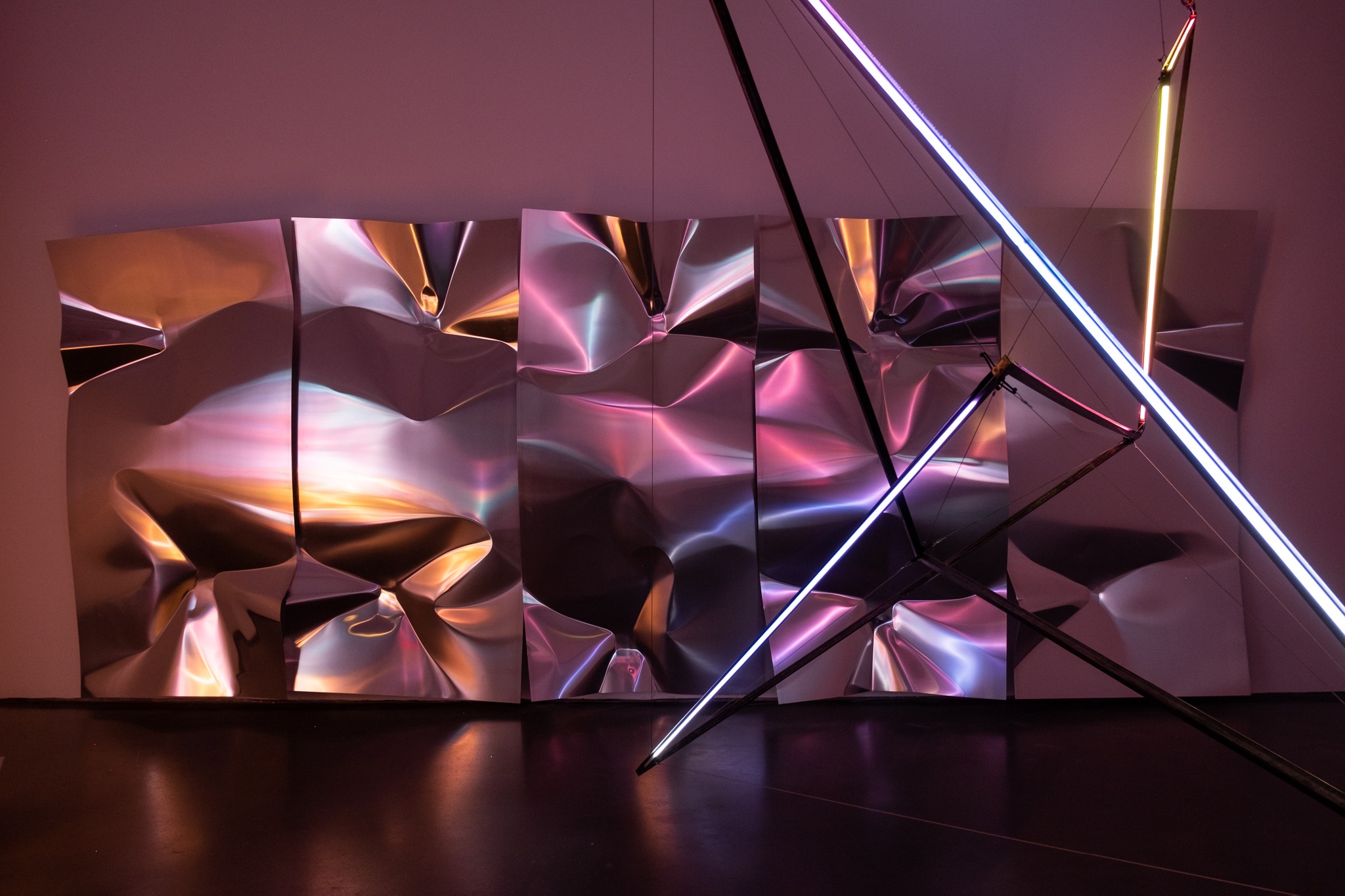
By Force of Circumstances (Hidilyn Diaz Crushed Metal) (2023) was produced in collaboration with Hidilyn Diaz. A wall of massive aluminum sheets were contorted under the force of hulking barbells dropped by Diaz onto their surface. They carry a visual record of gravity, power, and energy and might be taken as a metaphor for her historic imprint on her country.
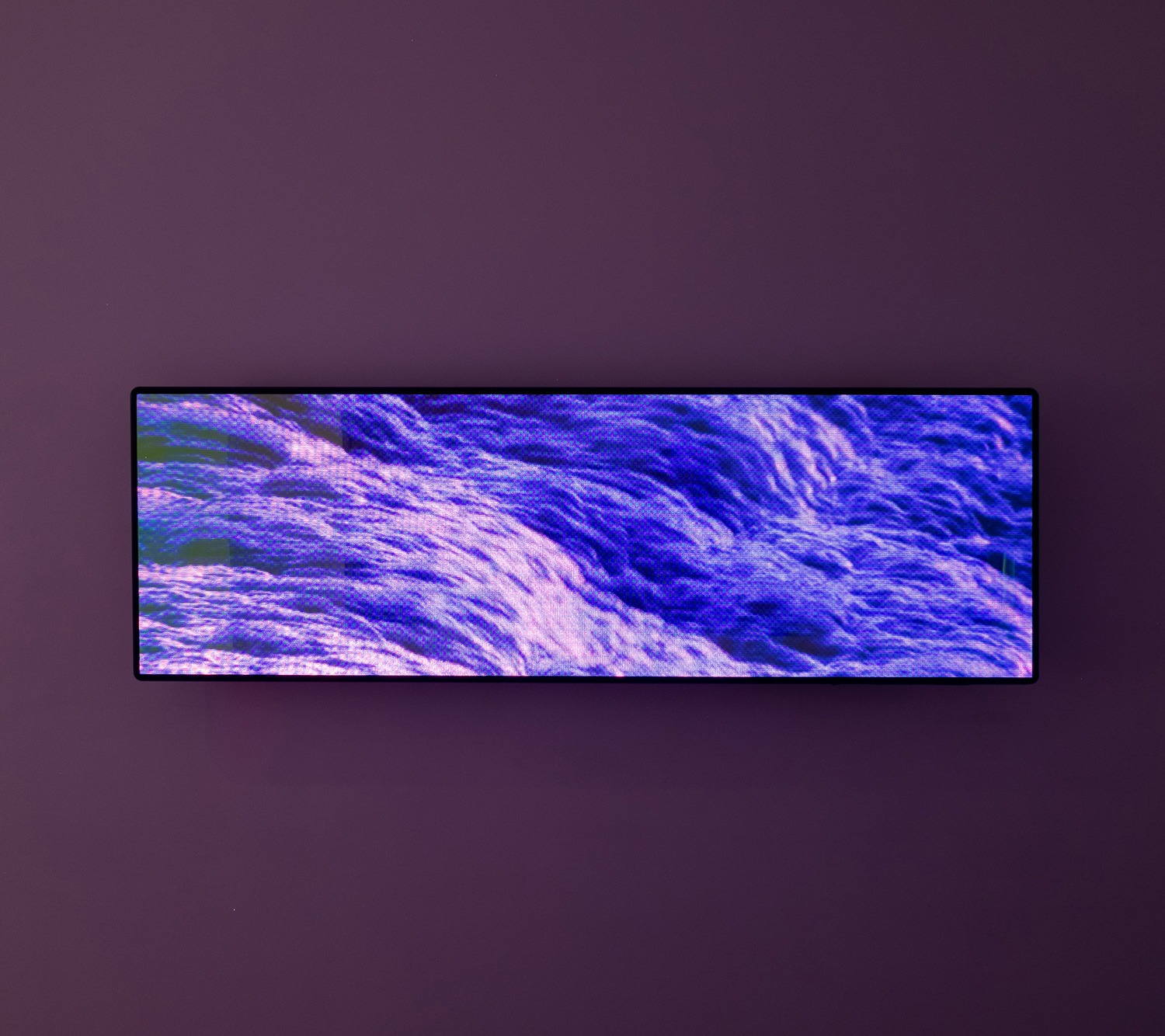
A 3D rendering of waves of liquid methane plays in a seamless loop. Humans have evolved in response to our surrounding environment, the ocean of methane here suggests a foreign planet and an alternative physical evolution. In this context, it asks us to imagine the people we might be if unmoored from the “home” we’ve known.
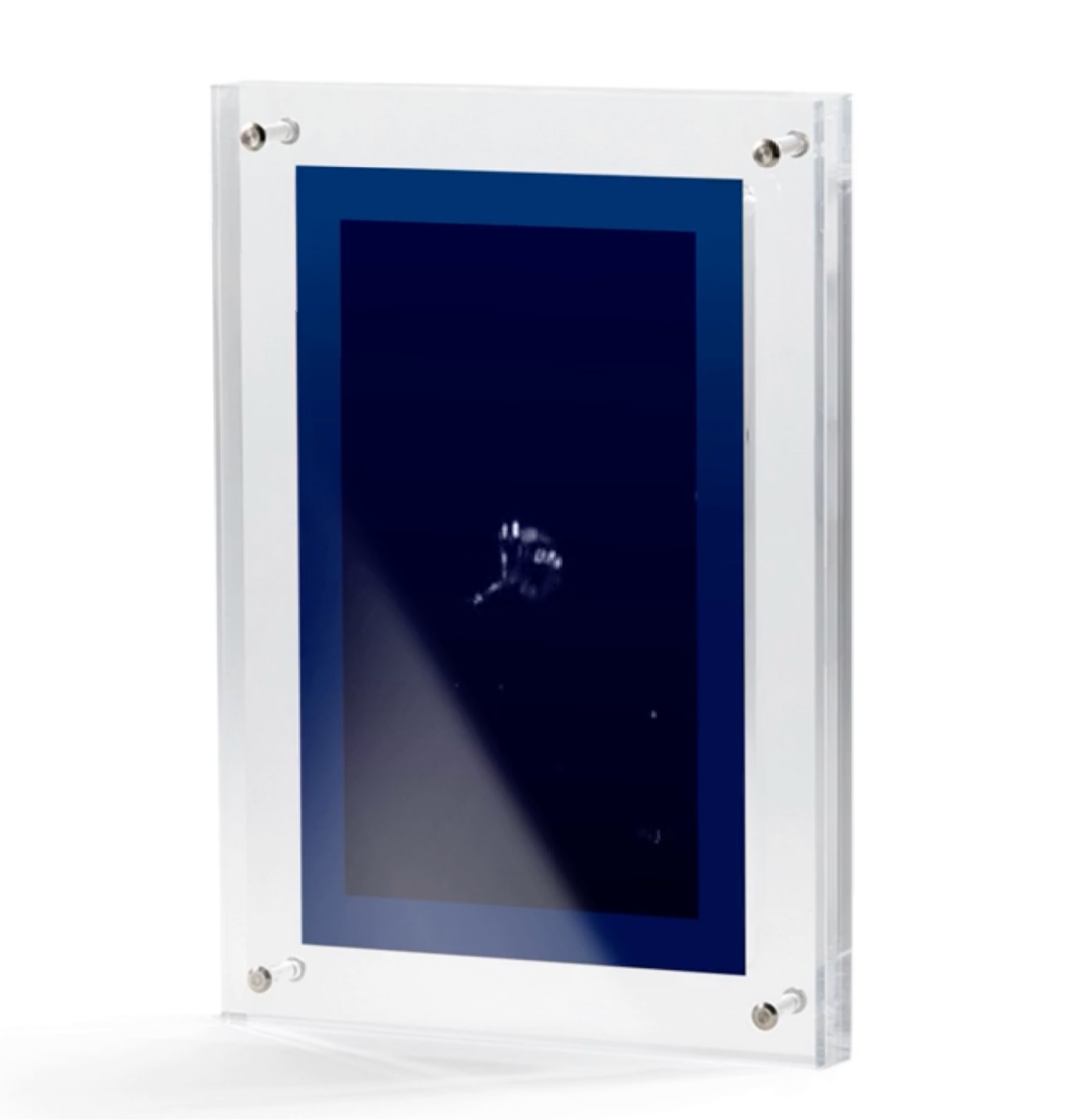
Recordings of a bubble traveling up a fish tank were motion-stabilized to the center of the frame. These clips were then stitched together seamlessly to cast the bubble on an endless journey to the surface. As the spherical ball of gas sits in the middle of the frame, it undulates, joins with other bubbles to get bigger, and splits into multiples. Once it reaches the surface it will no longer be a bubble but here its journey is perpetual.
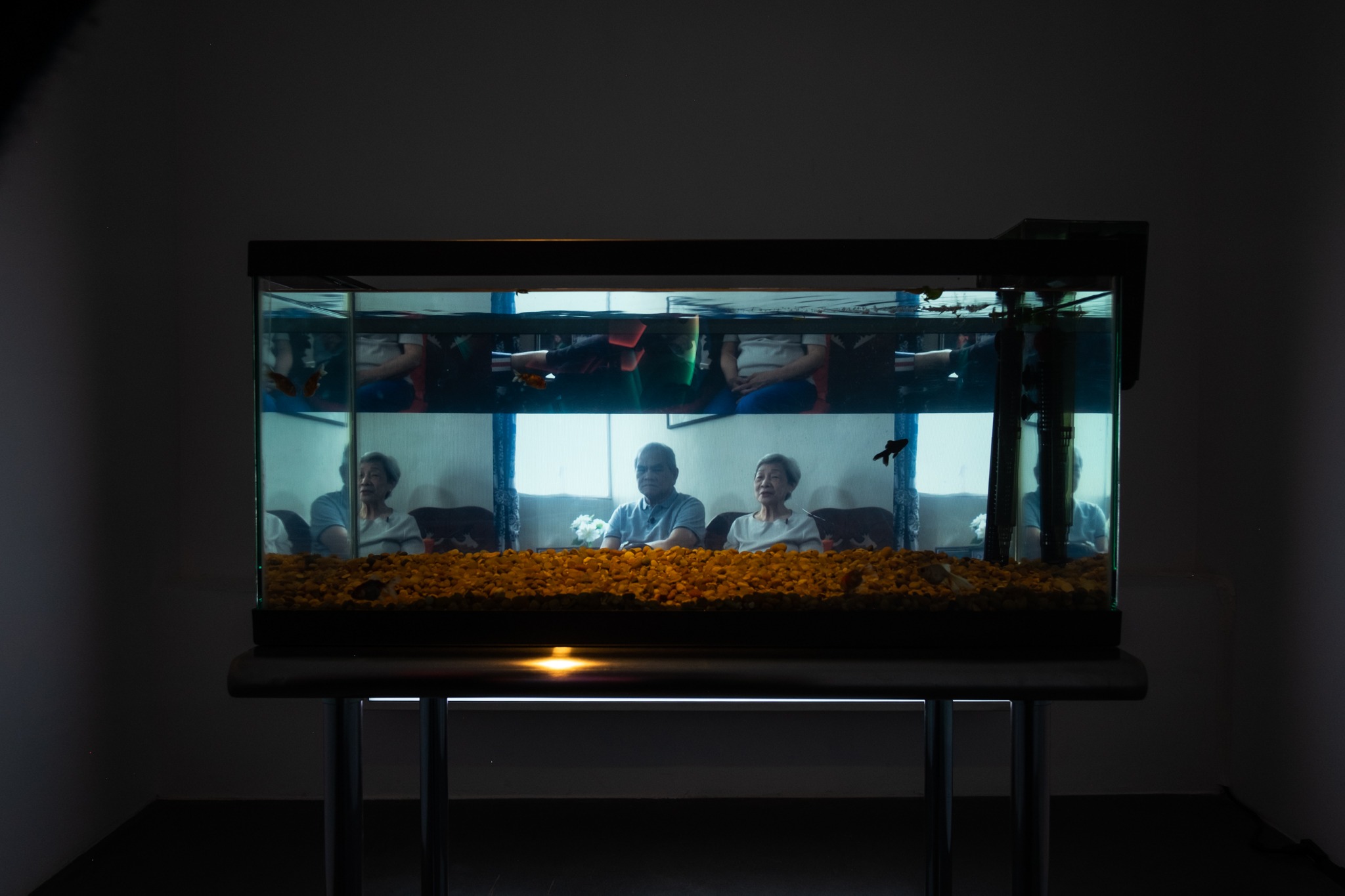
Video interviews with the parents of prominent Filipino artists play mysteriously in a fish tank while live goldfish swim within. The footage appears like a reflection on the tank’s glass due to the polarized screen attached to its sides. The darting fish might be proxies for the artists. As the parents speculate about their children’s careers and successes, they create a tangential portrait of the individual filtered through the lenses of familial perception and cultural identity.
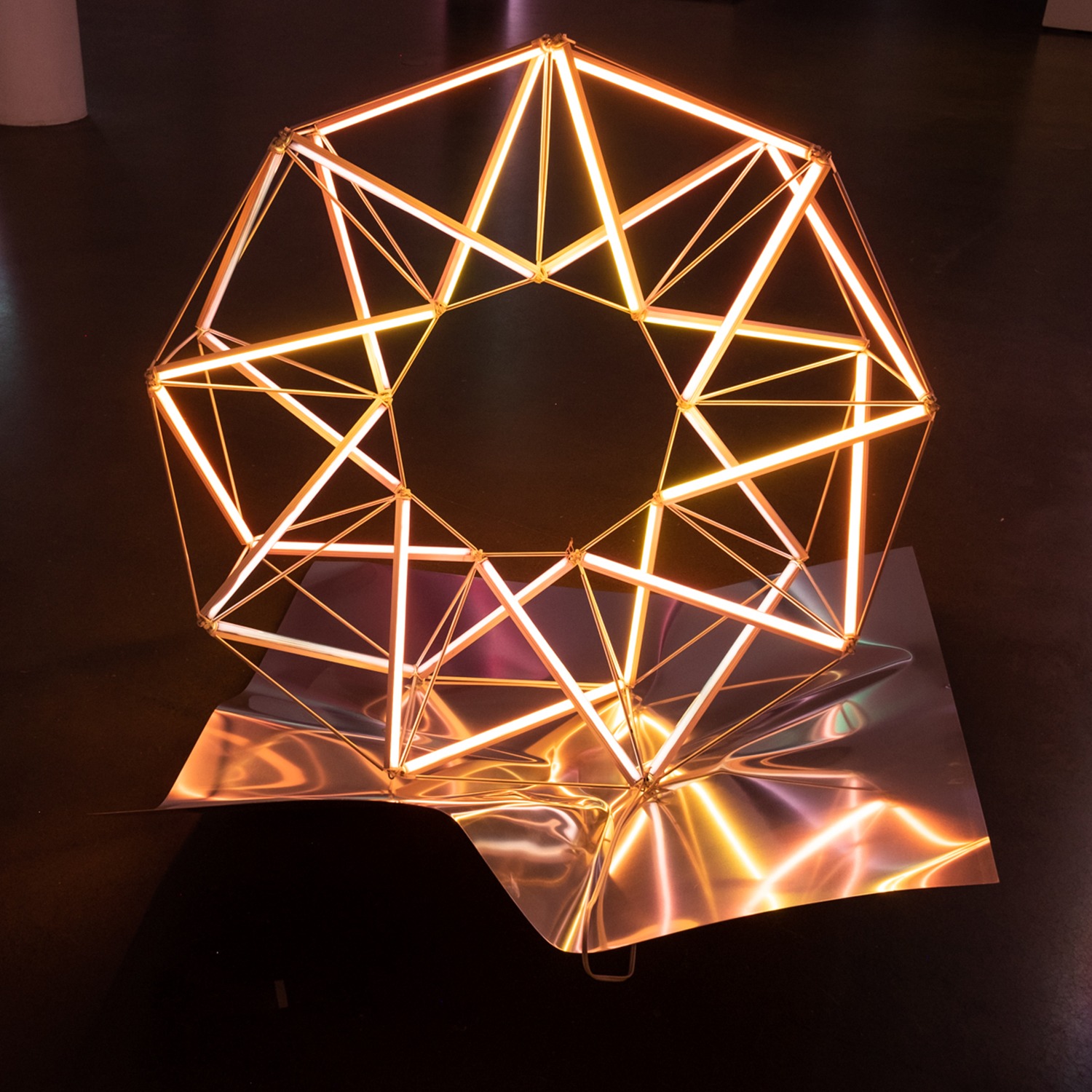
Magwheel Day and Magwheel Night are two structural tensegrity light sculptures in the form of the heavy rims used on semi-truck wheels. They reference the found objects an adolescent Hidilyn Diaz trained with before she could afford professional equipment and might be read as artifacts of ingenuity in the face of geo-political disparities.
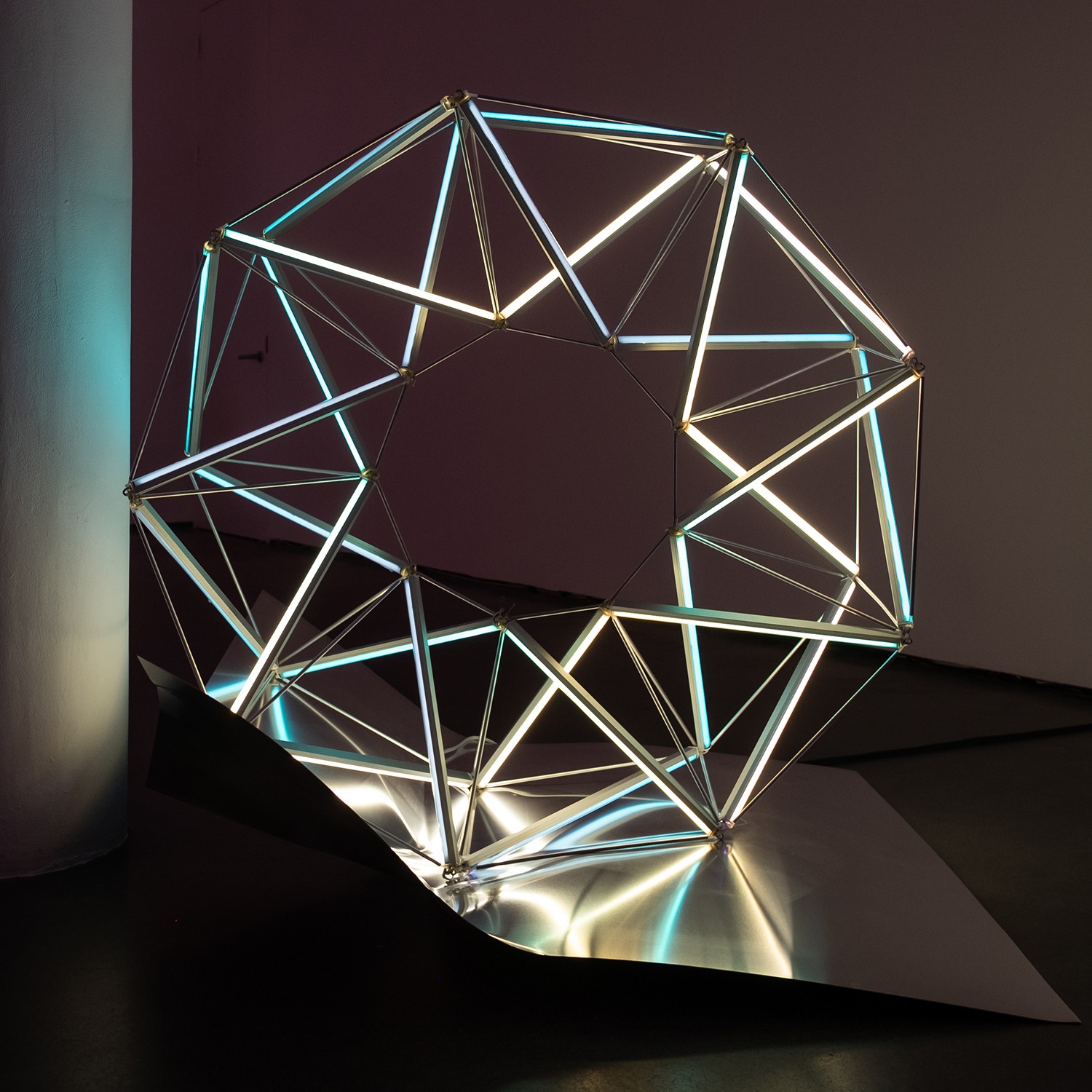
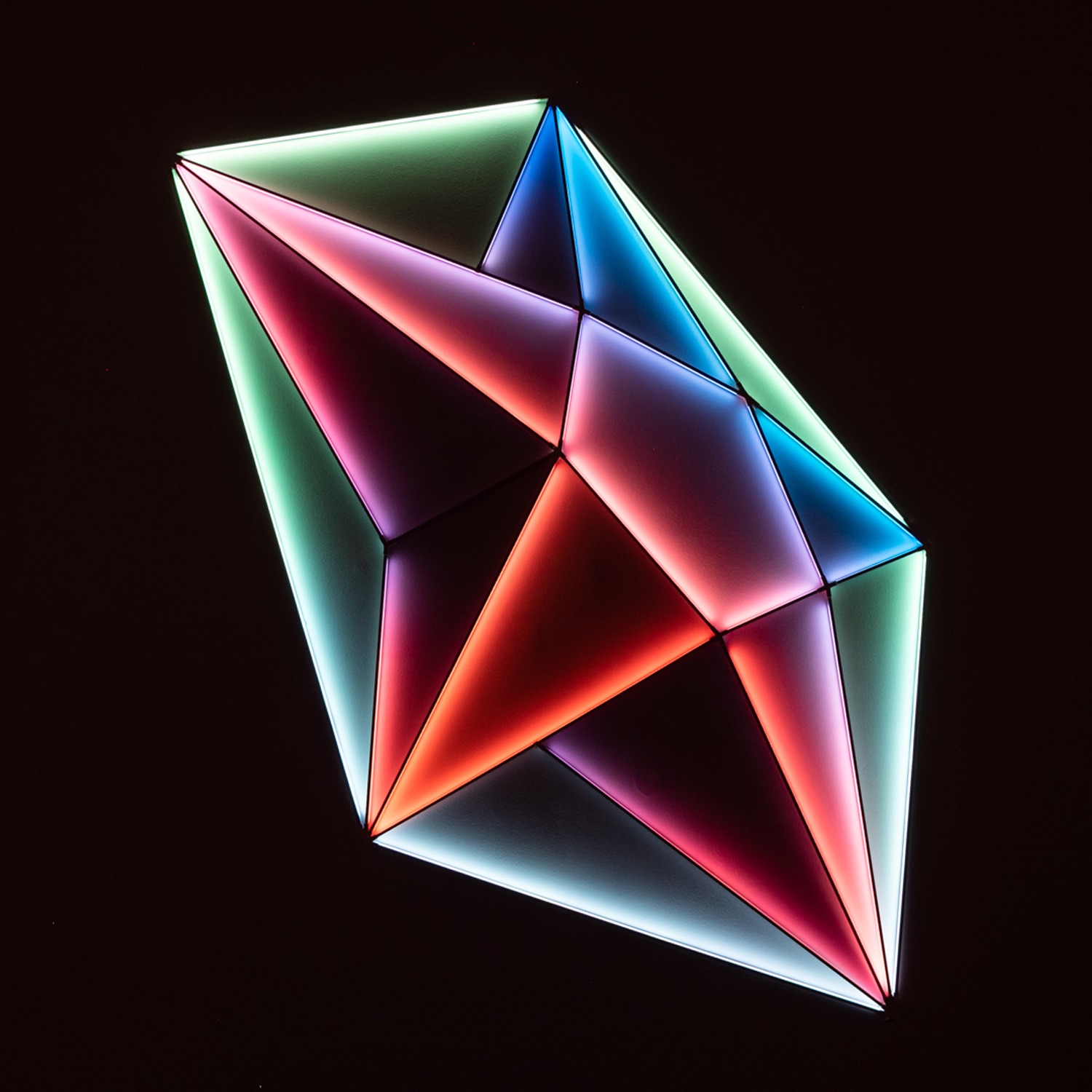
Parol #1 and Parol #4 are light works in the image of Filipino Parol lanterns, star-shaped Christmas lights linked to the nation’s Spanish and American colonial periods. A model of an individual star was built in a 3D rendering software, which became the basis for Parol #1. The resulting work was then photographed using a kaleidoscope lens to create the form of the new, fractalized light structure of Parol #4. Together they are expressions of the individual and the community.
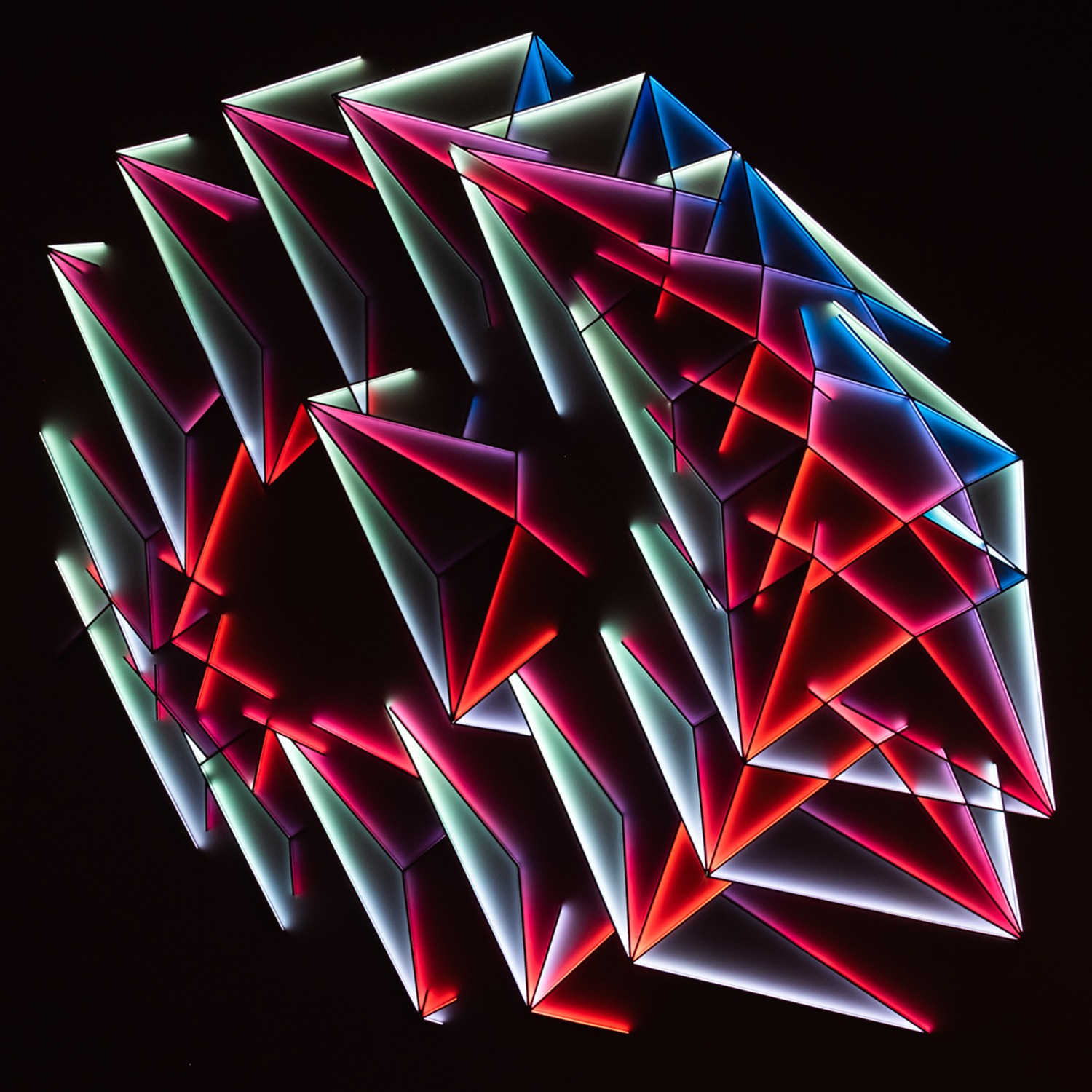
Parol #1 and Parol #4 are light works in the image of Filipino Parol lanterns, star-shaped Christmas lights linked to the nation’s Spanish and American colonial periods. A model of an individual star was built in a 3D rendering software, which became the basis for Parol #1. The resulting work was then photographed using a kaleidoscope lens to create the form of the new, fractalized light structure of Parol #4. Together they are expressions of the individual and the community.

